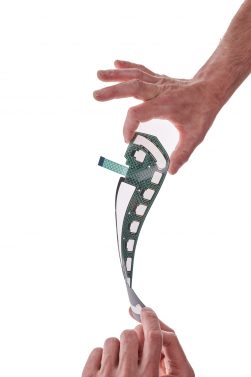Printed Electronics for Automotive Capacitive Human Machine Interfaces
Durability, ease of use, aesthetics and design have all been touted as benefits of capacitive touch controls in car interiors. For example, capacitive human machine interfaces (HMIs) enable buttons, sliders and touchpads to be located on different materials and in different shapes, resulting in smart surfaces on dashboards and consoles.

Flexible Printed Electronic HMI Foils Can Be Applied to Curved Surfaces
Touchscreens and capacitive buttons also give current car models a contemporary look and feel that match today’s digital world, and they bring smart technology to drivers’ fingertips. Furthermore, capacitive interfaces are solid-state electronics with no mechanical parts, enabling them to endure harsh automotive environments and heavy use.
The Technology Behind the Touch
As electronic HMI controls revolutionize the driving experience, capacitive touch technology will continue to be at the forefront of cutting-edge in-vehicle interfaces, along with the printing methods that enable them.
Indium Tin Oxide (ITO) is a transparent conductive material sputtered onto a polyester or glass substrate using physical vapor deposition. Like other capacitive sensing technologies, an ITO coating detects when a conductive object, such as a finger, enters the switch field. So, when a finger touches the ITO surface, the switch recognizes a change in capacitance and is actuated. ITO is widely used for touchscreens such as the ones you see on smartphones and GPS devices.
While ITO has superior clarity when thinly applied, its applications are limited because of its brittleness and cost. A few years back, its inherent weaknesses prompted a search for alternative materials. As a result, PEDOT and fine metal structures have been developed as economical alternatives to ITO and to broaden the applications for capacitive interfaces, such as their implementation on curved surfaces.
A Cost-Effective, Flexible Printing Option
PEDOT, an acronym for Poly (3,4-ethylenedioxythiophene), is a printable polymer with unique elastic, translucent and conductive properties. This near-colorless, water-soluble polymer mixture can be printed onto a variety of substrates, including polyethylene terephthalate (PET). Because of its transparency, PEDOT has proven to be extremely effective in applications such as backlit capacitive buttons, sliders and touchpads.

A Console Panel with Backlit Capacitive Buttons
Unlike ITO, which is a subtractive process that requires the etching away of unnecessary material, PEDOT is additive. It is printed only where needed as circuitry on inexpensive polyester film. Therefore, PEDOT is more economical and environmentally friendly than ITO, and it entails a more efficient manufacturing process. Additionally, PEDOT is flexible, unlike brittle ITO, so it can be incorporated onto curved surface designs. As a result, PEDOT enables cutting-edge automotive features. A few examples include backlit door trim panels, overhead and mid consoles, HVAC systems, and backlit infotainment controls on molded dashboard covers.
Ultimately, having alternative manufacturing methods, such as PEDOT, gives engineers a larger toolset from which to choose when designing touch-sensitive controls.
Leveraging Expertise for Complete Solutions
Molex engineers offer expertise on HMI applications and automotive requirements. They apply their expertise in the early design stages, and some of their recommendations may include:
- Design-to-PET film production process optimization (selection of materials, stack-up, testing)
- Selection of suitable ink/paste materials (Silver, PEDOT, carbon, dielectric)
- Signal routing and design (1- or 2-sided with vias, feature sizes, circuit layout)
- Additional optional features:
- Black overlays to avoid light-bleeding effects or adding graphics
- Adhesive material for front panel/trim-plate assembly
- Soft foam material as compensation in total mechanical design
- Backlighting performance improvement by integration of light diffuser film or ink
- Connectivity to the main PCB with Molex Easy-On FFC/FPC Connectors, FD-19 series
Molex’s core competency lies with its understanding of the electronics behind capacitive interfaces, which enables our engineers to provide design-to-cost and design-to-quality printed electronics solutions. As a result, Molex delivers today’s industry-leading printed electric circuits and PEDOT conductive sensors on a global scale and offers a roadmap that anticipates and overcomes tomorrow’s challenges.